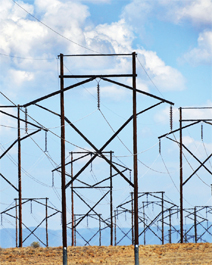
In August 2003, approximately 50 million people in the United States and Canada were plunged into darkness as the Northeast coast’s power grid experienced a massive failure. The region’s water supply, transportation, communications, and industry were all directly affected by the power loss, and some areas suffered looting during the blackout.
While the widespread North American blackout of 2003 was the result of human error and not terrorism, it illustrates the kind of disruptions that could be caused by malicious cyberterrorists. That’s why laboratory researchers are partnering with private industry to protect America’s electrical power grid.
The rationale behind the work is that international cyberterrorism remains a highly credible threat to the US and that vulnerability to attack lies in the nation’s increased reliance on automation, information, and communications technologies.
No enemy has yet successfully attacked the US power grid control network, but if it were to happen, it could be catastrophic. North America has more than 211,000 miles of high-voltage electrical transmission lines, carrying a net summer capacity of nearly 830 gigawatts (830,000 megawatts) to the customers of 3,100 electric utilities. These utilities have become more vulnerable as they have become more dependent on open information technology standards for their grid control systems.
Ethernet, TCP/IP, and web technologies are increasingly being used to manage power transmissions through supervisory control and data acquisition (SCADA) systems, many of which were originally designed and installed before modern IT systems were adopted.
These control systems, if not adequately protected, present potential opportunities for cyberterrorists to exploit. An assault on one part of a system will almost surely affect the operation of another part and the problem could propagate across the system.
A growing concern
Cyber attacks on IT systems are becoming increasingly more common. According to one expert estimate, there were 37,000 reported penetrations of government and private systems during fiscal 2007. Others estimate the numbers are much higher depending on the measured magnitude of the attacks, acknowledging that we may not know about all penetrations.
Additionally, information disclosed by a CIA analyst in January 2008 at a conference held by the SANS Institute reported that cyber attacks have successfully disrupted power equipment in several regions outside the US.
When the blackout of 2003 affected eight US states and the province of Ontario, it did so at a cost of $4 billion to $10 billion, which illustrates the importance of anticipating, detecting, and correcting disruptions in energy distribution systems spread across the nation.
Energy security experts point out that the 2003 blackout — one of several that occurred worldwide that year — could be replicated by cyberterrorists. Any system that relies on highly automated control networks can become the target of an intentional attempt to affect the operation of the devices and communication networks required to run the nation’s power system.
Investing in cybersecurity
Without a history of cyber attacks to provide object lessons, it is difficult for utilities to justify investments in additional protective measures. While the need for standardization became evident after the 2003 blackout, it is for the most part yet to be achieved. The slow pace of cybersecurity investment is of considerable concern to DOE and other organizations dedicated to the security of critical infrastructures. One of the goals of the DOE/industry programs is to develop secured interoperability among the various protective systems now on the market, so that as the utility corporations decide to invest in them, the security technology will be ready.
At Sandia, Robert Pollock (5633) is program lead for the National SCADA Test Bed (NSTB), and Ronald Halbgewachs (5633) and Jason Stamp (6332) are analysts for the Open Process Control System Security Architecture for Interoperable Design (OPSAID) part of NSTB. The group is part of a Sandia-based team that is working with colleagues at Pacific Northwest, Idaho, Oak Ridge, and Argonne national laboratories.
The National SCADA Test Bed is charged with identifying and solving SCADA vulnerability issues, testing new and existing equipment, and developing next-generation architectures and technology advances. In accordance with the emphasis on creating interoperability between security services for different vendors/systems, the NSTB program has developed the installation of crypto-security boxes as “bumps in the wire” that protect key components of transmission lines.
The OPSAID project, which began as a Sandia Laboratory Directed Research and Development project, is part of NSTB and provides a design basis for vendors such as Schweitzer Engineering Laboratory to build security devices that can be installed in control system networks.
The addition of these devices can increase the strength of security in older systems, while providing a foundation for the development of secure process control system elements in the future. In contrast to some security solutions, the OPSAID effort is based entirely on open-source software and standardized hardware, using an open architecture.